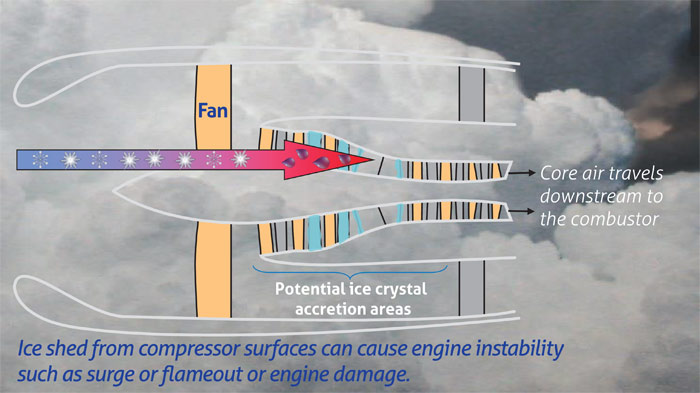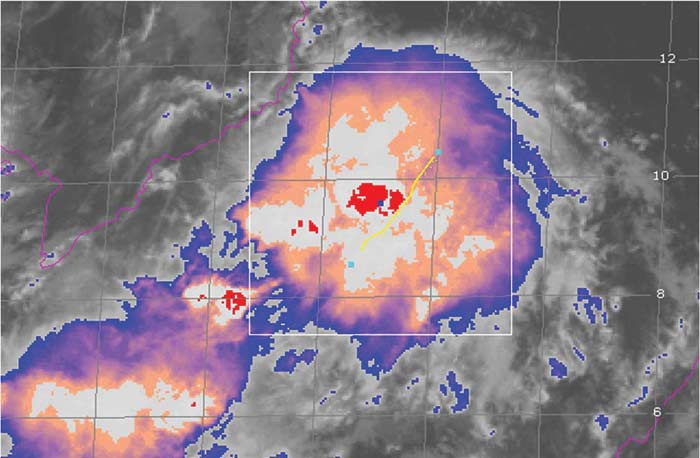Ice Crystals Ingestion and Your Aircraft's Engines
By F/O Bryan Lesko (United), Chairman, ALPA Aircraft Design/Operations Group
In April 1956, when two of the four turboprops on a BOAC Britannia flamed out at 20,000 feet over Africa on a route-proving flight to Nairobi, Kenya, it was a complete mystery. The engine’s design had successfully passed through intense ice-certification tests in Ottawa, Ont., and no airframe icing was present. It was later discovered that ice crystals had been sucked into the engine intakes, and the first ice crystal icing (ICI) ingestion event was recorded.
In the quest to make air travel even safer, technological advancements have led to a number of safety improvements. We’ve now reached a point where it isn’t what we can see and know about the weather that threatens our aircraft, it’s what isn’t easily visible and detectable that we must also take into consideration.
How it all happens
When a new aircraft engine is designed and built, it’s thoroughly tested in multiple regimes, including a variety of environmental conditions. For instance, all engines certified for use today must withstand having objects sucked into their engine—simulating the effects of something like birds being ingested into the fan blades.
Furthermore, engines are exposed to a variety of inclement weather, such as rain, hail, and ice. And while the concerns of water and hail ingestion are easy to understand, ice crystal icing is a relatively old phenomenon that we have only recently begun to comprehend.
These very small particles of ice are about the size of a particle of baking flour. Their extremely small size makes ice crystals very poor reflectors for onboard aircraft radar, making them difficult to locate and avoid. Once ingested, the ice can accrete on warm surfaces within the engine, cool, and refreeze, potentially causing temporary power loss or damage to the engine. Ice crystals can also accrete on a heated probe, clogging the probe and causing false air data indications.
Throughout the decades since 1956, more engine events attributable to ICI have been documented, some of which have resulted in compressor damage. This happens as the ice crystal accretions shake loose and fall into the core airflow of the engine. These occurrences can be categorized by power loss and/or compressor damage and are seen across all combinations of airframes and engines from large transport-category aircraft to smaller business aircraft.
Many different aircraft models, including transport-category aircraft, have experienced temporary uncommanded thrust loss or engine damage, generally after ice crystals are accreted to areas behind the fan in the core airflow path before shedding into the compressor (see Figure 1). This results in damage to the compressor’s blades, inlet guide vanes, stators, and/or boosters. Knowing this, engine and airframe manufacturers have continued to work to mitigate any engine effects experienced in ICI conditions.

Figure 1: Flow path of ice on the engine core. Source: Boeing Commercial Airplanes, ALPA review on ice crystal icing, July 2017
Location, location, location
As depicted in Figure 2, ice crystals are frequently encountered at subtropical latitudes—most often at altitudes above 22,000 feet and at temperatures warmer than a standard day. According to Boeing’s databases, many ICI events include a documented static air temperatures between −58° C to −3° C, with altitudes ranging from 11,000 feet up to FL450 with an average altitude of approximately FL350. What may be the most surprising is that more than 90 percent of these reported events occur between the latitudes of 32°S and 52°N—the tropical and subtropical latitude bands. Very few of these events are observed at latitudes greater than 38° in the northern hemisphere.

Figure 2: Map of Boeing ICI encounters. Source: Bravin, M., Strapp, J., and Mason, J., "An Investigation into Location and Convective Lifecycle Trends in an Ice Crystal Icing Engine Event Database," SAE Technical Paper 2015-01-2130, 2015, doi:10.4271/2015-01-2130
The reason greater numbers of ICI events occur between the tropical and subtropical latitude bands stems from the available moisture in the environment. Ice crystals are most prevalent during large collections of thunderstorms, known as a mesoscale convective system (MCS). These storms are often greater than 60 nautical miles in diameter and become organized on a scale larger than the individual thunderstorm but smaller than extratropical low-pressure systems. The massive size causes the system to persist usually for several hours, much longer than a typical thunderstorm.
Graphical depiction
Ice crystals are difficult to detect; however, the weather phenomenon that creates these crystals is far more obvious to detect. Figure 3 depicts an infrared (IR) satellite image of a large MCS, with an ICI encounter occurring at the location of the turquoise dot. The colors on the IR satellite image correspond to cloud-top temperature, with white and red the coldest temperatures. The red areas are local convective cores within the system, which correspondingly have the highest concentration of ice crystals.

Figure 3. Infrared satellite image showing aircraft track and location of ICI and cloud-top temperatures, with red the coldest. Source: Bravin, M., Strapp, J., and Mason, J., "An Investigation into Location and Convective Lifecycle Trends in an Ice Crystal Icing Engine Event Data-base," SAE Technical Paper 2015-01-2130, 2015, doi:10.4271/2015-01-2130
On the flight deck of most modern transport-category aircraft, there are several ways the presence of ice crystals or increased risk of ICI can be indicated to flight crews. The simplest—the aircraft being in IMC conditions—is not only a primary condition, but a physical requirement as ICI does not occur in clear air.
Furthermore, flight crews may also notice one or more of the following effects:
- Appearance of rain on the windscreen at flight level (but well above the freezing level),
- A “shh” sound on the windscreen,
- Speckled green returns at flight level on the weather radar,
- Total air temperature probe reading at or near 0° C,
- “St. Elmo’s Fire,”
- Ozone smell on the flight deck,
- Increased humidity on the flight deck,
- Sound of rain on the windscreen,
- Small collection of ice particles on wiper post, or
- Increased engine fan vibration.
Knowing this, many operators have incorporated ICI into the airplane flight manual. It is important that pilots become familiar with the appropriate section of the flight manual in case of a potential ICI event.
How you can help
If you encounter an ICI event, ALPA’s Air Safety Organization encourages you to fill out an ASAP report and provide details of the event in a feedback form available at www.alpa.org/icecrystalicingform. The information received through the feedback form will be used to facilitate industry research. The data will also be used to assess the ICI certification envelope within 14 CFR Part 33 Appendix D.
Get More Info
For more information or questions about ice crystal icing, contact F/O Bryan Lesko (United), chairman of ALPA’s Aircraft Design/Operations Group, at Bryan.Lesko@alpa.org.
‘Trapping’ Takeoff Misconfigurations
As the winter season is already upon us in some regions, many aircraft will need to deice and anti-ice before takeoff. Industry data indicate that ground deicing and anti-icing have the potential to lead to takeoff misconfigurations. Exercising good crew resource management, following standard operating procedures, and using threat and error management can “trap” these errors before pilots initiate the takeoff roll.
While the overall number of takeoff misconfigurations has decreased, the number of attempted zero-flap takeoffs has remained at a constant level. It’s important to be familiar with your airline’s operating procedures regarding the deicing and anti-icing process and the configuration of flaps/slats to ensure that the aircraft is properly configured for takeoff.

